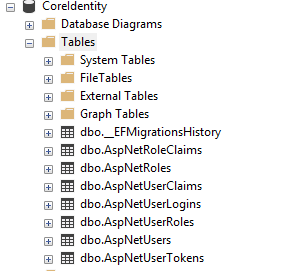ASP.NET Core Identity (edit)
ASP.NET Core CRUD with Bootstrap & Blazor
ASP.NET Identity 2.1
https://github.com/radenkozec/MySqlIdentity
ASP.NET Core Identity 2.0
https://docs.microsoft.com/en-us/aspnet/core/security/authentication/individual?view=aspnetcore-2.1
ASP.NET Core Identity 2.0 schema
ASP.NET Core 2.0 follows the Identity principle introduced in ASP.NET 4.5. Though the principle is shared, the implementation between the frameworks is different, even between versions of ASP.NET Core (see Migrate authentication and Identity to ASP.NET Core 2.0).
The fastest way to view the schema for ASP.NET Core 2.0 Identity is to create a new ASP.NET Core 2.0 app. Follow these steps in Visual Studio 2017:
- Select File > New > Project.
- Create a new ASP.NET Core Web Application, and name the project CoreIdentitySample.
- Select ASP.NET Core 2.0 in the dropdown, and then select Web Application. This template produces a Razor Pages app. Before clicking OK, click Change Authentication.
- Choose Individual User Accounts for the Identity templates. Finally, click OK, then OK. Visual Studio creates a project using the ASP.NET Core Identity template.
ASP.NET Core 2.0 Identity uses Entity Framework Core to interact with the database storing the authentication data. In order for the newly created app to work, there needs to be a database to store this data. After creating a new app, the fastest way to inspect the schema in a database environment is to create the database using Entity Framework migrations. This process creates a database, either locally or elsewhere, which mimics that schema. Review the preceding documentation for more information.
To create a database with the ASP.NET Core Identity schema, run the Update-Database command in Visual Studio's Package Manager Console (PMC) window—it's located at Tools > NuGet Package Manager > Package Manager Console. PMC supports running Entity Framework commands.
Entity Framework commands use the connection string for the database specified in appsettings.json. The following connection string targets a database on localhost named asp-net-core-identity. In this setting, Entity Framework is configured to use the DefaultConnectionconnection string.
{
"ConnectionStrings": {
"DefaultConnection": "Server=localhost;Database=aspnet-core-identity;Trusted_Connection=True;MultipleActiveResultSets=true"
}
}
This command builds the database specified with the schema and any data needed for app initialization. The following image depicts the table structure that's created with the preceding steps.

1) Mở tệp appsettings.json để chỉnh sửa connection string
{
"ConnectionStrings": {
"DefaultConnection": "Server=(localdb)\\mssqllocaldb;Database=ASPNETCoreNewDb;Trusted_Connection=True;MultipleActiveResultSets=true"
},
"Logging": {
"LogLevel": {
"Default": "Warning"
}
},
"AllowedHosts": "*"
}
2) Mở Package Manager Console để chạy lệnh Update-Database
Both Entity Framework Core and Entity Framework 6 are installed. The Entity Framework Core tools are running. Use 'EntityFramework\Update-Database' for Entity Framework 6.
Microsoft.EntityFrameworkCore.Infrastructure[10403]
Entity Framework Core 2.1.0-rtm-30799 initialized 'ApplicationDbContext' using provider 'Microsoft.EntityFrameworkCore.SqlServer' with options: None
Microsoft.EntityFrameworkCore.Database.Command[20101]
Executed DbCommand (9ms) [Parameters=[], CommandType='Text', CommandTimeout='30']
SELECT OBJECT_ID(N'[__EFMigrationsHistory]');
Microsoft.EntityFrameworkCore.Database.Command[20101]
Executed DbCommand (1ms) [Parameters=[], CommandType='Text', CommandTimeout='30']
SELECT OBJECT_ID(N'[__EFMigrationsHistory]');
Microsoft.EntityFrameworkCore.Database.Command[20101]
Executed DbCommand (2ms) [Parameters=[], CommandType='Text', CommandTimeout='30']
SELECT [MigrationId], [ProductVersion]
FROM [__EFMigrationsHistory]
ORDER BY [MigrationId];
Microsoft.EntityFrameworkCore.Migrations[20402]
Applying migration '00000000000000_CreateIdentitySchema'.
Applying migration '00000000000000_CreateIdentitySchema'.
Microsoft.EntityFrameworkCore.Database.Command[20101]
Executed DbCommand (8ms) [Parameters=[], CommandType='Text', CommandTimeout='30']
CREATE TABLE [AspNetRoles] (
[Id] nvarchar(450) NOT NULL,
[Name] nvarchar(256) NULL,
[NormalizedName] nvarchar(256) NULL,
[ConcurrencyStamp] nvarchar(max) NULL,
CONSTRAINT [PK_AspNetRoles] PRIMARY KEY ([Id])
);
Microsoft.EntityFrameworkCore.Database.Command[20101]
Executed DbCommand (1ms) [Parameters=[], CommandType='Text', CommandTimeout='30']
CREATE TABLE [AspNetUsers] (
[Id] nvarchar(450) NOT NULL,
[UserName] nvarchar(256) NULL,
[NormalizedUserName] nvarchar(256) NULL,
[Email] nvarchar(256) NULL,
[NormalizedEmail] nvarchar(256) NULL,
[EmailConfirmed] bit NOT NULL,
[PasswordHash] nvarchar(max) NULL,
[SecurityStamp] nvarchar(max) NULL,
[ConcurrencyStamp] nvarchar(max) NULL,
[PhoneNumber] nvarchar(max) NULL,
[PhoneNumberConfirmed] bit NOT NULL,
[TwoFactorEnabled] bit NOT NULL,
[LockoutEnd] datetimeoffset NULL,
[LockoutEnabled] bit NOT NULL,
[AccessFailedCount] int NOT NULL,
CONSTRAINT [PK_AspNetUsers] PRIMARY KEY ([Id])
);
Microsoft.EntityFrameworkCore.Database.Command[20101]
Executed DbCommand (2ms) [Parameters=[], CommandType='Text', CommandTimeout='30']
CREATE TABLE [AspNetRoleClaims] (
[Id] int NOT NULL IDENTITY,
[RoleId] nvarchar(450) NOT NULL,
[ClaimType] nvarchar(max) NULL,
[ClaimValue] nvarchar(max) NULL,
CONSTRAINT [PK_AspNetRoleClaims] PRIMARY KEY ([Id]),
CONSTRAINT [FK_AspNetRoleClaims_AspNetRoles_RoleId] FOREIGN KEY ([RoleId]) REFERENCES [AspNetRoles] ([Id]) ON DELETE CASCADE
);
Microsoft.EntityFrameworkCore.Database.Command[20101]
Executed DbCommand (2ms) [Parameters=[], CommandType='Text', CommandTimeout='30']
CREATE TABLE [AspNetUserClaims] (
[Id] int NOT NULL IDENTITY,
[UserId] nvarchar(450) NOT NULL,
[ClaimType] nvarchar(max) NULL,
[ClaimValue] nvarchar(max) NULL,
CONSTRAINT [PK_AspNetUserClaims] PRIMARY KEY ([Id]),
CONSTRAINT [FK_AspNetUserClaims_AspNetUsers_UserId] FOREIGN KEY ([UserId]) REFERENCES [AspNetUsers] ([Id]) ON DELETE CASCADE
);
Microsoft.EntityFrameworkCore.Database.Command[20101]
Executed DbCommand (3ms) [Parameters=[], CommandType='Text', CommandTimeout='30']
CREATE TABLE [AspNetUserLogins] (
[LoginProvider] nvarchar(128) NOT NULL,
[ProviderKey] nvarchar(128) NOT NULL,
[ProviderDisplayName] nvarchar(max) NULL,
[UserId] nvarchar(450) NOT NULL,
CONSTRAINT [PK_AspNetUserLogins] PRIMARY KEY ([LoginProvider], [ProviderKey]),
CONSTRAINT [FK_AspNetUserLogins_AspNetUsers_UserId] FOREIGN KEY ([UserId]) REFERENCES [AspNetUsers] ([Id]) ON DELETE CASCADE
);
Microsoft.EntityFrameworkCore.Database.Command[20101]
Executed DbCommand (2ms) [Parameters=[], CommandType='Text', CommandTimeout='30']
CREATE TABLE [AspNetUserRoles] (
[UserId] nvarchar(450) NOT NULL,
[RoleId] nvarchar(450) NOT NULL,
CONSTRAINT [PK_AspNetUserRoles] PRIMARY KEY ([UserId], [RoleId]),
CONSTRAINT [FK_AspNetUserRoles_AspNetRoles_RoleId] FOREIGN KEY ([RoleId]) REFERENCES [AspNetRoles] ([Id]) ON DELETE CASCADE,
CONSTRAINT [FK_AspNetUserRoles_AspNetUsers_UserId] FOREIGN KEY ([UserId]) REFERENCES [AspNetUsers] ([Id]) ON DELETE CASCADE
);
Microsoft.EntityFrameworkCore.Database.Command[20101]
Executed DbCommand (1ms) [Parameters=[], CommandType='Text', CommandTimeout='30']
CREATE TABLE [AspNetUserTokens] (
[UserId] nvarchar(450) NOT NULL,
[LoginProvider] nvarchar(128) NOT NULL,
[Name] nvarchar(128) NOT NULL,
[Value] nvarchar(max) NULL,
CONSTRAINT [PK_AspNetUserTokens] PRIMARY KEY ([UserId], [LoginProvider], [Name]),
CONSTRAINT [FK_AspNetUserTokens_AspNetUsers_UserId] FOREIGN KEY ([UserId]) REFERENCES [AspNetUsers] ([Id]) ON DELETE CASCADE
);
Microsoft.EntityFrameworkCore.Database.Command[20101]
Executed DbCommand (1ms) [Parameters=[], CommandType='Text', CommandTimeout='30']
CREATE INDEX [IX_AspNetRoleClaims_RoleId] ON [AspNetRoleClaims] ([RoleId]);
Microsoft.EntityFrameworkCore.Database.Command[20101]
Executed DbCommand (1ms) [Parameters=[], CommandType='Text', CommandTimeout='30']
CREATE UNIQUE INDEX [RoleNameIndex] ON [AspNetRoles] ([NormalizedName]) WHERE [NormalizedName] IS NOT NULL;
Microsoft.EntityFrameworkCore.Database.Command[20101]
Executed DbCommand (1ms) [Parameters=[], CommandType='Text', CommandTimeout='30']
CREATE INDEX [IX_AspNetUserClaims_UserId] ON [AspNetUserClaims] ([UserId]);
Microsoft.EntityFrameworkCore.Database.Command[20101]
Executed DbCommand (1ms) [Parameters=[], CommandType='Text', CommandTimeout='30']
CREATE INDEX [IX_AspNetUserLogins_UserId] ON [AspNetUserLogins] ([UserId]);
Microsoft.EntityFrameworkCore.Database.Command[20101]
Executed DbCommand (1ms) [Parameters=[], CommandType='Text', CommandTimeout='30']
CREATE INDEX [IX_AspNetUserRoles_RoleId] ON [AspNetUserRoles] ([RoleId]);
Microsoft.EntityFrameworkCore.Database.Command[20101]
Executed DbCommand (1ms) [Parameters=[], CommandType='Text', CommandTimeout='30']
CREATE INDEX [EmailIndex] ON [AspNetUsers] ([NormalizedEmail]);
Microsoft.EntityFrameworkCore.Database.Command[20101]
Executed DbCommand (1ms) [Parameters=[], CommandType='Text', CommandTimeout='30']
CREATE UNIQUE INDEX [UserNameIndex] ON [AspNetUsers] ([NormalizedUserName]) WHERE [NormalizedUserName] IS NOT NULL;
Microsoft.EntityFrameworkCore.Database.Command[20101]
Executed DbCommand (2ms) [Parameters=[], CommandType='Text', CommandTimeout='30']
INSERT INTO [__EFMigrationsHistory] ([MigrationId], [ProductVersion])
VALUES (N'00000000000000_CreateIdentitySchema', N'2.1.0-rtm-30799');
Done.
